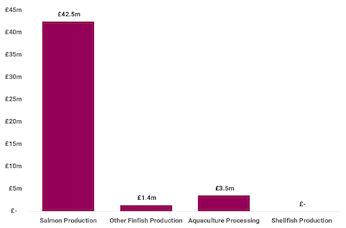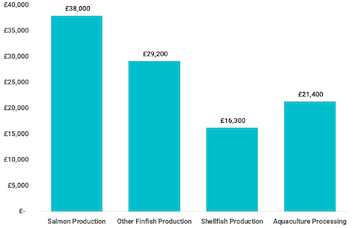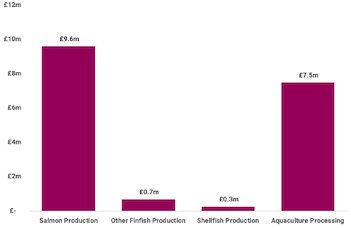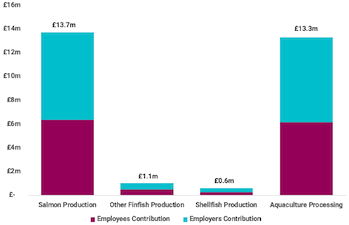Aquaculture sector - wider economic impacts: estimates
This study provides the estimates of the direct, indirect and wider economic impacts of the Scottish aquaculture sector for 2018, including associated tax receipt estimates.
7. Fiscal Impacts
This section considered the fiscal contribution that was made in 2018 by the Scottish aquaculture sector. It considers Income Tax, National Insurance Contributions and Corporation Tax.
7.1 Corporation Tax
The aquaculture sector makes an annual contribution to public finances through the payment of Corporation Tax. The contribution made by salmon production, aquaculture processing, other finfish production and shellfish production was considered in turn.
To estimate the Corporation Tax paid by salmon producers, taxes on profits for the SSPO members were sourced from their 2018 annual accounts[18]. These were then scaled up to account for the remaining share of the sector. In this way, it was estimated that in 2018 salmon producers contributed £42.5 million in Corporation Tax.
To estimate the Corporation Tax contribution of the processing sector, the analysis relied on data from Companies House on the taxes on profits paid by:
- Mowi Consumer Products UK Limited;
- Marine Products Scotland Limited;
- Nolan Seafoods;
- Farne Salmon & Trout Limited;
- Lions Speciality Foods Limited; and
- Aquascot.
Where the businesses considered were not exclusively processors of aquaculture products their profits were weighted by the share of production that was attributable to aquaculture. In this way, it was estimated that in 2018 these producers accounted for around 48% of the sector’s turnover. The remainder of Corporation Tax for the processing of aquaculture was imputed.
The Corporation Tax contribution of other finfish producers was modelled based on salmon production. The largest producer of other finfish did not report any corporation tax paid in 2018 and this was therefore taken into consideration in the analysis. For this reason, to estimate 2018 profits in the production of other finfish, the share of profits per turnover for salmon production was multiplied by the turnover from other shellfish products. The 19% rate of Corporation Tax was then applied.
It was assumed that the shellfish sector made a minimal contribution towards Corporation Tax in 2018. This assumption was based on a review of accounts published in this subsector and the ownership structure of the sector and on its employment structure.

Source: BiGGAR Economics Analysis
7.2 Income Tax
To estimate the income tax contribution made by those employed in the aquaculture industry, it was first necessary to estimate the average salary paid in each of its subsectors.
Staff costs were the starting point in estimating the income tax contribution made by employees. To isolate the gross wages paid by the companies in the sector in 2018, it was necessary to establish the share of staff costs that was paid out in salaries and wages. Based on an analysis of the accounts of representative companies across aquaculture processing, salmon production and other finfish production, it was established that gross wages corresponded to about 88% of staff costs.
At this point, the staff costs for each of the subsectors of Scottish aquaculture were multiplied by 88%. The total gross wage costs obtained in this way were then divided by the number of employees working in each subsector to obtain an estimate of the average salaries and wages paid.
These were in line with the average staff costs estimated in the previous chapter. In 2018 finfish and, in particular, salmon production was associated with the highest gross salaries and wages.

Source: BiGGAR Economics Analysis
At this point, the income tax contribution associated with these average wages was estimated and then scaled by the number of people employed in each sector. In this way, it was estimated that in 2018 the aquaculture sector’s employees contributed around £18.1 million.
In 2018, the largest income tax contribution was made by salmon production. This was associated to the higher salaries and wages paid on average by the companies operating in this subsector. Aquaculture processing contributed a further £7.5 million.
The level of employment and pay is lowest in the shellfish production subsector. This subsector also includes the highest proportion of companies with one or two people. For the purposes of this analysis it was assumed that the earnings associated with these companies were paid as salaries and the individuals were employed by the incorporated organisation. This was done to reflect the larger concentrations of employment in Shetland based mussel producers and the number of incorporated companies in this subsector.

Source: BiGGAR Economics
7.3 National Insurance Contribution
The contribution made by the sector through the payment of National Insurance was estimated based on employees’ payments and employers’ contributions.
To estimate the contribution made by employers, staff costs by sector as estimated in the previous section were multiplied by 8%, the average share of National Insurance contributions with respect to total annual costs for the companies taken as representative of the sector.
In this way, it was estimated that in 2018 employers across the aquaculture sector paid £15.3 million in National Insurance contributions.
The estimation of the National Insurance contribution paid by the sector’s employees was similar to that of income tax, estimated in the previous section. The average salaries and wages paid in each sector were used to estimate the National Insurance contribution of the average employee. These were then scaled up based on each sector’s direct employment.
In this way, it was estimated that in 2018 employees and employers in the Scottish aquaculture sector contributed a total £28.6 million in National Insurance contributions.
| £ million | |
|---|---|
| Employers National Insurance Contribution | 15.3 |
| Employees National Insurance Contribution | 13.3 |
| Total | 28.6 |
Source: BiGGAR Economics Analysis
In 2018 salmon production was the subsector within Scottish aquaculture that made the largest contribution towards National Insurance, around £14 million. The remainder mostly arose from aquaculture processing. Most of the difference between the contribution of the two subsectors came from employer’s contribution, which was larger because of the larger number of people employed in aquaculture processing. The contribution of salmon production employees was relatively larger due to the higher salaries paid in the sector.

Source: BiGGAR Economics Analysis
Contact
There is a problem
Thanks for your feedback